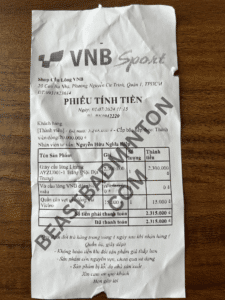
When I first looked into the Li-Ning Saga 2 SE, I didn’t know what to expect since none of the pro players on the World Tour prefers it.
Most of Li-Ning’s marketing material seems only available in Mandarin Chinese. So between vague online product descriptions and my attempts to translate their 2024 catalog with Google Lens, I was stuck with the usual keywords that badminton brands seem to throw around all their flagship shoes like “comfort”, “anti-bounce”, and “improved footwork”.
It didn’t make things better that the Li-Ning Saga II also comes in Pro and Max editions. Both seem to have the same marketing description, albeit with a sock-like design instead of the traditional tongue, and the Max edition having BOA dials as well.
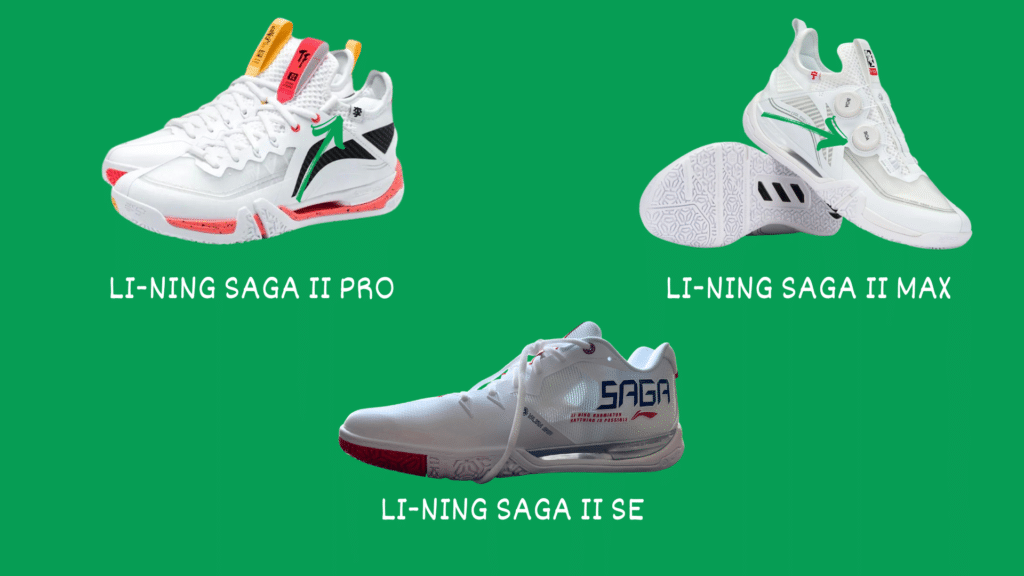
Looking at this shoe, I realized that you’ll likely be as confused as I was, so I decided to get a pair and clarify things in my quest for the perfect pair of badminton shoes for me.
Based on how they felt playing in along with their weight, I categorize this pair as a supportive shoe, falling exactly in the middle between the comfort and injury preventive subcategories.

You’d think most supportive badminton shoes would fall into this middle-of-the-road blend, but that hasn’t been my experience. I enjoy this balance, though, and I’d love to see more like it.
The Saga II SE weighs 413g per shoe in my size 28.5 cm, which is the heaviest badminton shoe I’ve tested thus far.
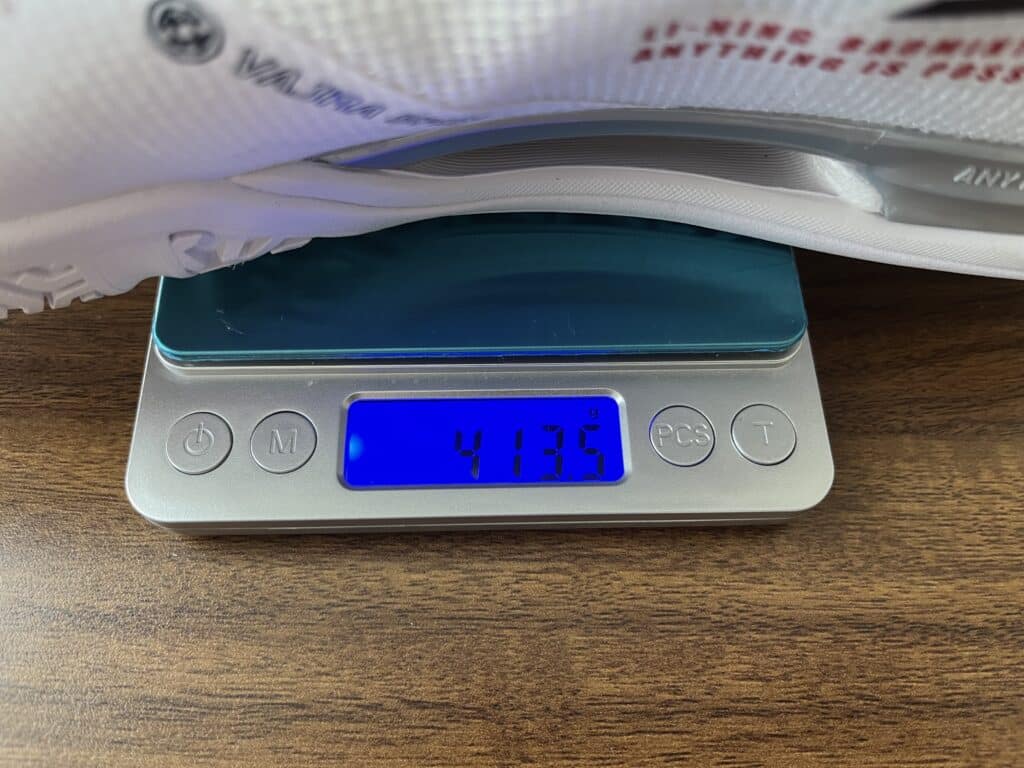
I had to weigh it several times to be convinced that I had gotten it correct as it’s about 10% heavier than other supportive and bulky shoes I’ve come across.
Table of Contents
Li-Ning Saga 2 SE review and my experience
Now, let’s dive into the Li-Ning Saga 2 SE review.
Unboxing and first impressions
As usual with my shoe reviews, I’ve had this pair on court for ten hours to test how they feel as an intermediate player.
Let’s see how they play!
Fit + upper shoe area
It continues to surprise me just how big of a difference the tongue and shoelaces can have from one pair of top-tier badminton shoes to another.
Some shoelaces feel like they’re magically untying themselves while some tongues keep sliding down to the side and tweak the fit around the ankle. I find it frustrating as hell, but I’m happy to report that this isn’t the case on the Li-Ning Saga II SE.
The rest of the upper feels a tad narrow (which I prefer), and super breathable. It seems like most of this area is made of some transparent material we know from running shoes that function to keep the shoe on your feet without overheating too much.
That is especially necessary for this pair due to the crazy weight, and I found that they feel less hot to play in than, say, the Yonex Eclipsion Z3 despite it weighing less than the Saga.
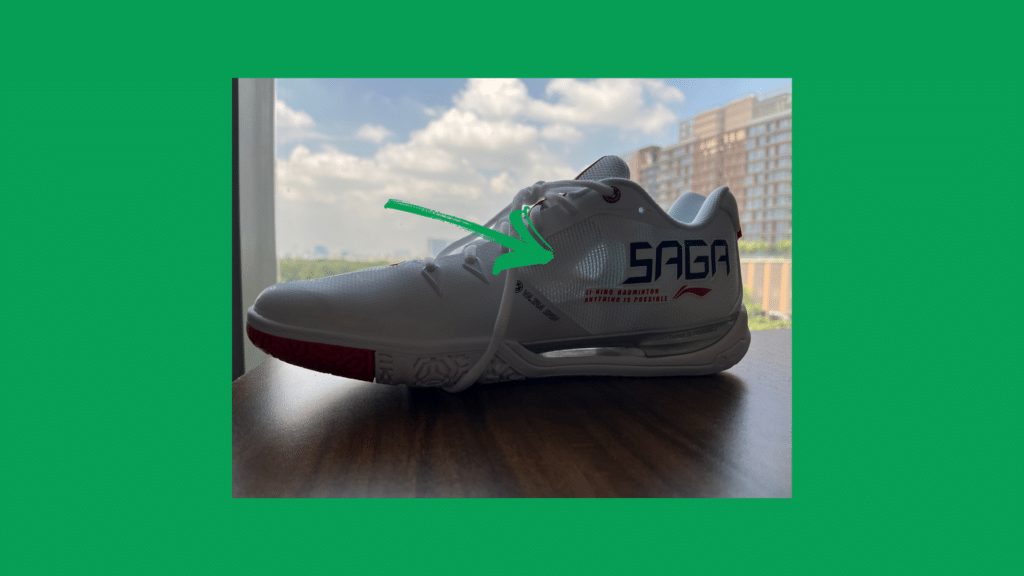
The heel area
The heel felt on the narrow side of the middle and offered good snug support with a blend of a soft cushion on the inside and a stiffer outer area.
The cushion was comfy, but not as thick as on the Li-Ning Yun Ting, where some players feel concerned that it’ll be too easy to roll their ankles while playing in them.
The heel is tall enough combined with a slightly stiff upper area that goes up near the ankle and makes it feel protective from your ankle moving around too much within the shoe.
Cushion and shock absorption
One of the first things I think about when testing a new badminton shoe is how fatigued I feel underneath my feet after playing in this shoe and whether I can make it through a session without issues.
Here, the Saga II SE gave me no problems and recovery was easy as I’d expect from a shoe this heavy — after all, if we don’t get some level of shock absorption or comfort, what do we need all that weight for?
The funky outsole, almost separated from the midsole and the rest of the shoe, appeared to help mitigate shock absorption. I say “appeared” because something did help but if not that, I’m not sure which part of the shoe it was.
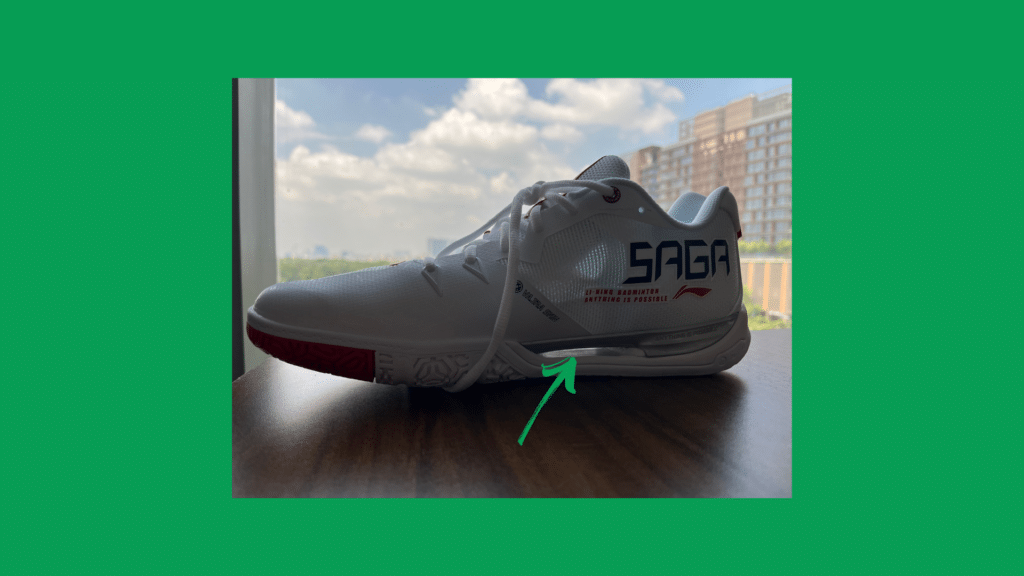
That being said, this shoe falls somewhere in the middle when it comes to a comfortable cushion and shock absorption.
The insole had a nicely soft and slightly thick texture with the wave design by the toe area to prevent sliding within the shoe, which we know from other badminton shoes.
But this is the first time I’ve come across that insole on a badminton shoe within the supportive category, which is a nice surprise as it’s my favorite type of insole.
The outsole and grip
The grip feels good and on par with Yonex’s radial blade sole grip which I’ve come to love for its glue-like and sticky qualities.
As confusing as it is, where Yonex uses the same outsole grip on all their flagship shoes, Li-Ning has used three different grips on the three top-tier shoes I’ve tested from their 2024 catalog.
Moving on to the rest of the outsole, the toe and heel area are connected to increase stability on landings. That weird-looking “plate” that makes up the outsole gave me confidence that I’d land as planned from jumps on lunges rather than the shoe flexing and causing a slight ankle roll as I’ve gotten mild injuries from several times in the past.
The toe area and protection
The first thing I noticed in the toe box was that it felt nicely narrow and suitable for my feet (I have feet that are slightly on the narrow side).
As a player with mediocre footwork and heavy landings, I’m often late to the shuttle, which means my toes have a fair chance of bumping against the very front of the shoe. That can be painful throughout a session, so I tend to prefer a good chunk of padding in the toe box of my badminton shoes.
The Saga II SE has good protection here, even if it isn’t as much as, say, the Yonex Eclipsion Z3 which is ridiculously well-padded.
It felt reasonable, but I wish it had a touch more padding underneath the toe box to protect my toe area on heavy landings as I did feel some fatigue in this area after each session I played. If your footwork is better than mine and you don’t land as heavy, this might not be an issue for you.
Durability
Durability is hard to determine after just testing a pair of badminton shoes for ten hours on court. To get a clue relative to other pairs I test, I like to look at two areas: the lunge tear and the outsole tear.
The lunge tear comes on the side of the non-racket shoe facing your other shoe while lunging. Many top-tier badminton shoes deliberately add extra padding in this area to improve durability, but it doesn’t appear like the Saga II SE has any.
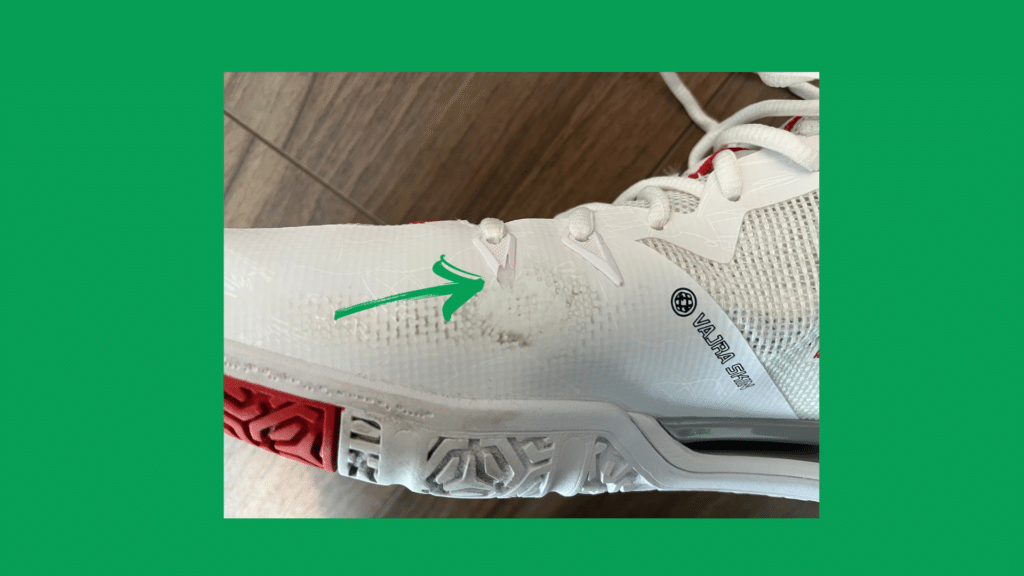
It also looks like the ring surrounding the shoelace hole nearby is too close and the otherwise nice cover got scratched from the first session I had them on court. This seems like a failure in product design and we’ll see how long this lasts when I test them against other shoes in the future.
For now, it looks ok, even if I wish the otherwise nice-looking little detail wouldn’t have come off so easily.
The outsole tear also comes on the non-racket foot, but on the outsole as we’re turning and moving around on the court. This looks to be in great shape, so no complaints there.
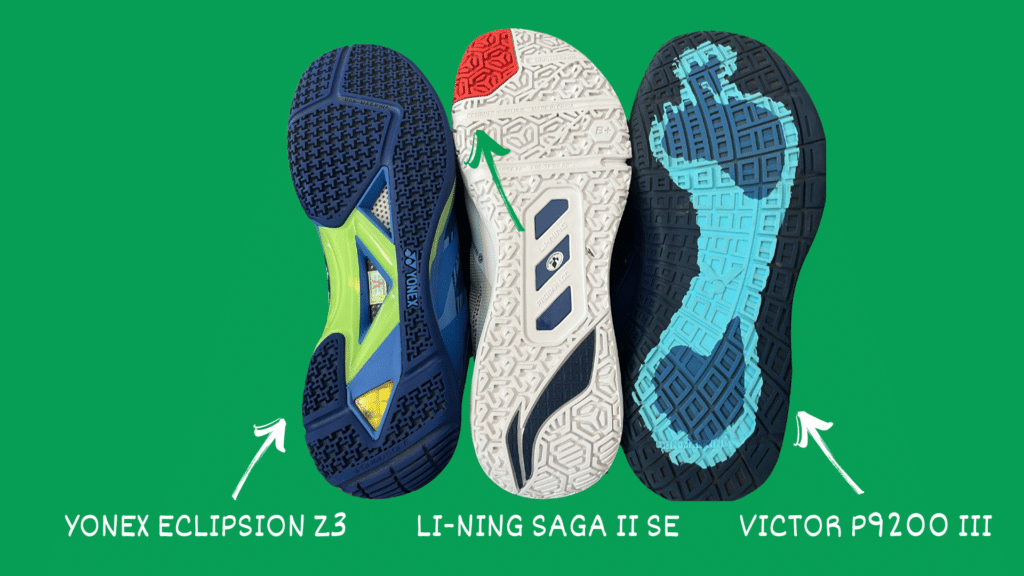
The overall verdict
POSITIVE
Great blend between comfort and injury prevention (cushion and stiffness).
NEGATIVE
Super heavy.
To conclude this Li-Ning Saga II SE, let’s look at the verdict.
Li-Ning Saga 2 SE: the verdict

Summary + the beasty score
It’s a tad too heavy and bulky for me, which is a shame because the shape and narrow width fit my feet perfectly. I also like how it blends a fairly soft and comfortable inner cushion with a stiffer outer area from heel to toe.
Speaking of toes, I found the toe box to be decent, but I prefer more padding underneath my toes despite the front of the toe box and the midsole under the rest of my feet being fine.
The grip and outsole plate were fine and felt stable during landings combined with good heel support from the tall and fairly stiff upper heel area.
Surprisingly, the Saga II SE didn’t feel hot to play in despite being about ten percent heavier than other supportive badminton shoes, due to its very breathable and almost transparent upper area. The shoelaces and tongue in that area caused no issues either.
Overall, I’ve enjoyed testing this shoe and it comes close to being a great choice for my feet except that it’s a tad too bulky for me.
This shoe strikes me as a niche pair for heavy players with narrow feet due to its weight.
Which badminton players are best suited for Li-Ning Saga II SE
Next, let’s get a sense of which type of player this shoe is for.
Who Li-Ning Saga II SE is suited for
This Saga II SE is well suited for bigger players with narrow feet who prefer a comfortable injury-preventive badminton shoe.
Who Li-Ning Saga II SE is not suited for
You might not like this shoe if your feet have an average width or even slightly on the wide side of the middle, or if you have about the same body size as me or smaller.
I imagine that this pair will feel extra heavy and bulky while you’re moving around on court.
Li-Ning Saga II SE compared to other similar shoes
As the last step in this Li-Ning Saga 2 SE review, let’s compare it with other similar shoes head-to-head.
Li-Ning Saga II SE vs Yonex Eclipsion Z3
Yonex’s Eclipsion Z3 is roughly the equivalent of this Li-Ning pair in terms of categorization.
The Eclipsion Z3 is less comfortable, feels stiffer, and has a wider nature that better fits players with average- or slightly wide feet, even if they aren’t wide enough to fit the wide edition.
In terms of injury prevention, these two pairs are similar. The Eclipsion feels like it’s going all-in on injury prevention with a super tall and stiff heel and crazy padding in the toe box, but just a touch of comfort overall.
While it certainly feels stable to play in, the Saga has somehow managed to take things a step further with its outsole plate. It feels more cool and comfortable overall, except in the toe box where the Eclipsion has more padding than I’ve come across on any other badminton shoe thus far.
Li-Ning Saga II SE vs Victor P9200 III
The Victor P9200 III feels more spongy and bouncy as you’re landing and moving around the court compared to the Saga II SE due to its drop-in midsole.
In fact, the P9200 III is the most comfortable badminton shoe I’ve tested and gives me the least fatigue after playing. On the other hand, the Saga feels more injury preventive with a nice tall and slightly stiff heel, whereas the P9200 III’s heel is too low for my liking.
The P9200 III feels like wearing one big cushion from heel to toe and gave me no issues despite my slightly narrow even. Even so, the Saga felt like the fit was slightly better, not just in the toe box, but due to being slightly stiffer and less cushioned I noticed a more snug feel all around my feet.
This could be an illusion as more stiffness can feel less comfortable, but more snug, without actually being it due to your feet sinking into the couchy cushion of the P9200 III.